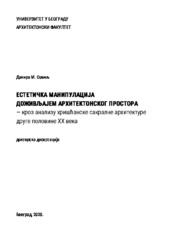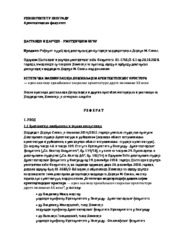Приказ основних података о дисертацији
Естетичка манипулација доживљајем, архитектонског простора - кроз анализу хришћанске сакралне архитектуре друге половине XX века
Aesthetic manipulation of the experience of architectural space - through an analysis of Christian sacral architecture of the second half of the XX century
| dc.contributor.advisor | Mako, Vladimir | |
| dc.contributor.other | Vujović, Milan | |
| dc.contributor.other | Milenković, Vladimir | |
| dc.contributor.other | Gvozdenović, Vasilije | |
| dc.creator | Sovilj, Danira | |
| dc.date.accessioned | 2021-12-10T15:23:14Z | |
| dc.date.available | 2021-12-10T15:23:14Z | |
| dc.date.issued | 2021-02-11 | |
| dc.identifier.uri | http://eteze.bg.ac.rs/application/showtheses?thesesId=8389 | |
| dc.identifier.uri | https://fedorabg.bg.ac.rs/fedora/get/o:24582/bdef:Content/download | |
| dc.identifier.uri | http://vbs.rs/scripts/cobiss?command=DISPLAY&base=70036&RID=37604873 | |
| dc.identifier.uri | https://nardus.mpn.gov.rs/handle/123456789/18734 | |
| dc.description.abstract | Предочена дисертација је усмерена на истраживање архитектонског простора као вида комуникације. У тој комуникацији долази до интензивног односа између простора и корисника. Стога, истраживање је фокусирано на доживљај архитектонског простора у процесу такве комуникације. Ако се пође од тога да је архитектонски простор дефинисан низом аспеката, физички присутних или само сугерисаних, ти аспекти представљају предмет истраживања, као и перцептивна својства укупне архитектонске композиције. То подразумева изучавање начина на које је могуће манипулисати елементима архитектонске форме и њиховим односима, како би се утицало на опажање или начин коришћења од стране корисника. Други део истраживања усмерен је на архитектуру хришћанских сакралних објеката друге половине XX века. Сакрална архитектура је позиција изражене двосмерне комуникације између корисника и простора, те манипулације обликовањем и амбијенталношћу, зарад постизања специфичног доживљаја простора и спиритуалног искуства. Обликовањем архитектонског простора гради се контемплативан амбијент који исказује трансцендентно и „неизрециво“. Примери из датог периода дају увид у савремене интерпетације сакралне архитектуре и нове начине обликовања експресивних сакралних простора. Циљ рада се огледа у испитивању начина на које архитектонски простор утиче на корисника, и предвиђању усмеравања доживљаја његових сегмената или целине. Током истраживања, фокус се ставља на сакралну архитектуру, као полигон за испитивање манипулације доживљајем простора. Предност се даје примерима архитектонских објеката прочишћеног израза без примене декоративних елемената, те је циљ истраживања анализа и експликација примене сведених архитектонских елемената као јединих инструмената којима се граде експресивни и/или контемплативни простори. | sr |
| dc.description.abstract | The present dissertation focuses on the research of architectural space as a form of communication. In this communication, an intense relationship between the space and its user occurs. Therefore, the research is focused on the experience of architectural space in the process of this type of communication. If we start from the fact that architectural space is defined by a range of aspects, physically present or only suggested, those aspects represent the subject of this research and the perceptual properties of the overall architectural composition. That entails studying the ways in which one can manipulate the elements of the architectural form and their relations, in order to influence the user’s perception or the way they use the space. The second part of the research is focused on the architecture of Christian sacral buildings from the second half of the XX century. Sacral architecture is a space of pronounced two-way communication between the user and the space, and also of manipulation through design and ambiance, in order to achieve a specific experience of the space and a spiritual experience. By shaping the architectural space, a contemplative ambiance that expresses the transcendent and the “ineffable” is built. Examples from the given period provide an insight into modern interpretations of sacral architecture and the new ways of shaping expressive sacral spaces. The study aims to examine the ways in which architectural space affects the user and to predict the direction of the experience of its segments or the entire space. I In the research process, the focus is placed on sacral architecture, as a polygon for examining the manipulation of the experience of space.. Preference is given to examples of architectural objects of polished expression without the application of decorative elements, and the research aims to analyze and explain the application of subdued architectural elements as the only instruments used to build expressive and/or contemplative spaces. | en |
| dc.format | application/pdf | |
| dc.language | sr | |
| dc.publisher | Универзитет у Београду, Архитектонски факултет | sr |
| dc.rights | openAccess | en |
| dc.rights.uri | https://creativecommons.org/licenses/by-nc-nd/4.0/ | |
| dc.source | Универзитет у Београду | sr |
| dc.subject | доживљај простора | sr |
| dc.subject | experiencing space | en |
| dc.subject | опажање | sr |
| dc.subject | перцепција | sr |
| dc.subject | комуникација у архитектури | sr |
| dc.subject | усмеравање доживљаја | sr |
| dc.subject | естетичка манипулација | sr |
| dc.subject | observing | en |
| dc.subject | perception | en |
| dc.subject | communication in architecture | en |
| dc.subject | directing the experience | en |
| dc.subject | aesthetic manipulation | en |
| dc.title | Естетичка манипулација доживљајем, архитектонског простора - кроз анализу хришћанске сакралне архитектуре друге половине XX века | sr |
| dc.title.alternative | Aesthetic manipulation of the experience of architectural space - through an analysis of Christian sacral architecture of the second half of the XX century | en |
| dc.type | doctoralThesis | |
| dc.rights.license | BY-NC-ND | |
| dcterms.abstract | Мако, Владимир; Миленковић, Владимир; Вујовић, Милан; Гвозденовић, Василије; Совиљ, Данира; Estetička manipulacija doživljajem, arhitektonskog prostora - kroz analizu hrišćanske sakralne arhitekture druge polovine XX veka; | |
| dc.identifier.fulltext | http://nardus.mpn.gov.rs/bitstream/id/77568/Disertacija_11721.pdf | |
| dc.identifier.fulltext | http://nardus.mpn.gov.rs/bitstream/id/77569/Izvestaj_Komisije_11721.pdf | |
| dc.identifier.rcub | https://hdl.handle.net/21.15107/rcub_nardus_18734 |



